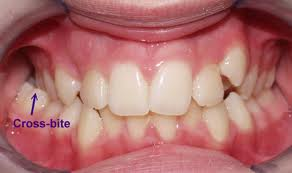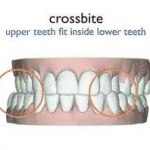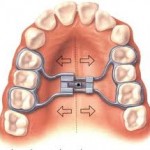Crossbite is an occlusal irregularity where a tooth (or teeth) has a more buccal or lingual position (that is, the tooth is either closer to the cheek or to the tongue) than its corresponding antagonist tooth in the upper or lower arcade.
Terminology and classification
 Crossbite can involve a single tooth or a group of teeth. It can be classified in anterior or posterior and bilateral or unilateral.
Crossbite can involve a single tooth or a group of teeth. It can be classified in anterior or posterior and bilateral or unilateral.
An anterior cross bite can not be referred as negative overjet, and is typical of class III skeletal relations (prognathism).
Posterior crossbite is often correlated to a narrow maxilla and upper dental arch. A posterior cross-bite can be unilateral or bilateral. Unilateral cross-bite often determines a lateral shift of the mandibular position, which can become structural if left untreated for a long time during growth, leading to skeletal asymmetries.
Posterior crossbite is also known as “reverse articulation”.
Causes of crossbite:
The causes of a crossbite are usually hereditary and come from your genes. In other cases, it can be a delayed loss of baby teeth or an unusual eruption of the teeth. If it is a genetic problem, the bone of the lower jaw is usually wider than the bone of the upper jaw. It can cause the teeth to be misaligned on one side of the mouth or on both sides of the mouth.
 If it is from a delayed loss of a baby tooth or an abnormally erupted tooth, it can affect just a portion of the occlusion. Some people keep their baby teeth so long that their permanent teeth come in behind their baby teeth, like a second row of teeth. Thumb sucking can contribute to a crossbite by constricting the width of the palate and deforming the upper bone of the palate. It usually does not correct itself and needs some kind of orthodontic correction.
If it is from a delayed loss of a baby tooth or an abnormally erupted tooth, it can affect just a portion of the occlusion. Some people keep their baby teeth so long that their permanent teeth come in behind their baby teeth, like a second row of teeth. Thumb sucking can contribute to a crossbite by constricting the width of the palate and deforming the upper bone of the palate. It usually does not correct itself and needs some kind of orthodontic correction.
In rare cases, the presence of mouth breathing can cause defects in the shape of the maxilla and can affect teeth alignment. Large adenoids and tonsils can also spur the development of a crossbite. If a child’s adenoids and tonsils are too large, it may force a child to breathe through their mouth instead of their nose. The difference may seem innocuous, but it can actually affect proper jaw growth: When a child breathes through the nose, the tongue is positioned on the roof of the mouth, which helps the jaws to grow laterally. But if a child is forced to breathe through the mouth, the tongue shifts out of position and away from the roof of the mouth, causing the jaws to grow asymmetrically.
Symptoms:
The symptoms of a crossbite can be painful chewing and a painful jaw and teeth. It can also affect chewing in such a way that the temporomandibular joint (TMJ) or jaw joint is inflamed. This inflammation causes pain in the TMJ and sometimes headaches.
Complications:
Complications of a crossbite can be periodontitis and gingivitis, tooth loss due to malocclusion and degeneration of the temporomandibular joint, causing arthritis of the TMJ and wearing away of the joint surface. This can result in the need for surgery to replace the TMJ completely.
Crossbite prevention:
You can prevent a crossbite by stopping thumb sucking early in life so the upper palate does not become narrowed and malformed. You can have the baby teeth removed when expected so that the adult tooth beneath it doesn’t have to come out crooked. Many types of crossbite, however, cannot be prevented and must be treated when noted.
Treatment
Crossbite should be corrected because it may:
- cause premature wear of the teeth.
- cause gum disease including bone loss.
- cause asymmetrical development of the jaws.
- cause dysfunctional chewing patterns.
- make your smile less attractive.
There are several therapies that can be used to correct a cross bite: braces, quad helix, removable plates, clear aligner therapy, or a Delaire mask. The correct therapy should be decided by the orthodontist depending on the type and severity of the crossbite.
If mouth breathing is part of the cause, a tonsillectomy and adenoidectomy should be performed before the patient undergoes orthodontic therapy. The first part of treatment involves maxillary expansion. This makes the upper jaw broader using a maxillary expander. It widens the jaw when worn nightly for a couple of months. A key turns the device and gradually increases the width of the palate.
After the palate has expanded enough, orthodontic devices are necessary to straighten the teeth. This means a full set of braces for a total of one to two years in order to create an ideal bite.
